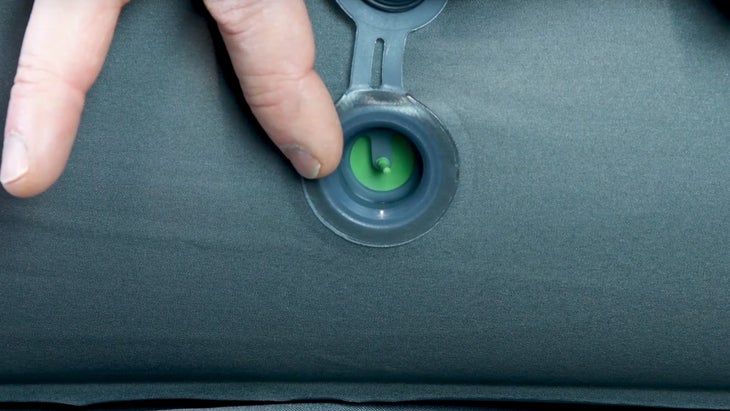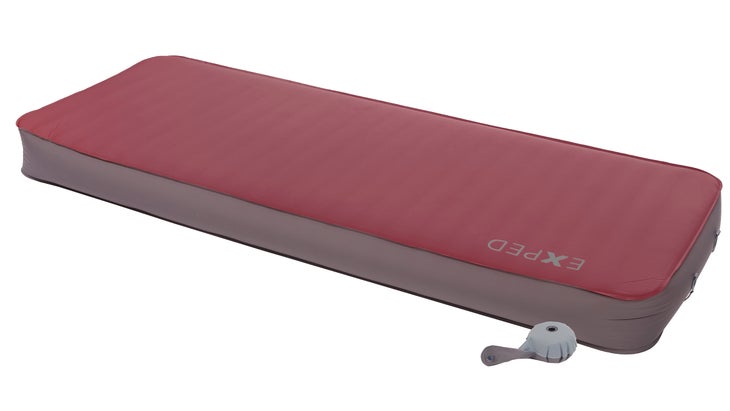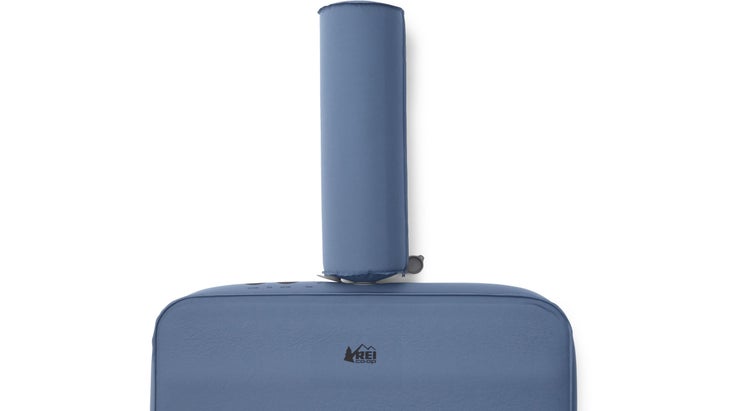Products You May Like
Many of us hit a point in our lives where we don’t want to rough it on a closed-cell foam sleeping mat or lightweight air pad at basecamp. That means investing in a more deluxe sleep system. Luckily, several brands on the market offer ultra-cush car camping pads that bring you about as close as possible to getting the same kind of sleep as you do at home. But deluxe car camping pads can be very pricey. To that end, we pitted one of the most affordable pads in this category, the REI Co-op Camp Dreamer XL Self-Inflating Deluxe Bed against one of the most expensive, the Exped MegaMat Max 15.
To set the stage, there are a few things that did not factor into our comparison. Both pads have a very high R-Value, or the measure of a sleeping pad’s insulation, adequate to keep you comfortable even on the snow. (For the record, the Exped has a significantly higher R-Value at 10.6). The MegaMat is nearly double the weight of the Camp Dreamer at just over 13 pounds, though both are heavy enough that you won’t want to carry them backpacking. They pack down to nearly the same size, with the MegaMat just 3 inches thicker when rolled up. With that out of the way, let’s get to the good stuff.

Ease of Setup/Breakdown
MegaMat Max: Like many Exped pads, the MegaMat Max has both an inflation and deflation valve. The two-way inflation valve also allows you to slowly release air by simply pressing on it, which makes fine-tuning the firmness of your mattress incredibly easy and precise. For inflation, Exped includes a comically small “Mini Pump” that you can either press or step on. Despite the fact that this pad is “self-inflating,” we’ve never successfully fully inflated the pad with the Mini Pump, although we estimate it would take 5-10 minutes of continuous pumping. We would recommend buying Exped’s USB-rechargeable Widget Pump ($49) or any other powered or manual pump with a compatible connector.
Camp Dreamer: The Camp Dreamer comes with a creatively-designed rotating valve, where one side allows for inflation and the other prevents air loss. To deflate, rotate the valve halfway, keeping it just slightly ajar for fine-tuning. (An idiot-proof diagram next to the valve shows you how to operate it.) We found this valve system to be unnecessarily finicky, making it difficult to know when the valve is fully seated on the inflation side or sealed side. Once correctly seated, we had no problems with leakage, however. And although we’ve read anecdotal complaints about leaky valves, we assume it’s due to user error rather than an actual manufacturing defect. On the plus side, the Camp Dreamer’s large, foam-framed pump fills the pad (also technically self-inflating) in a minute or two and functions as a very comfortable, adjustable pillow.
Winner: The Camp Dreamer. While REI’s valve design is annoying and imprecise, Exped’s underpowered pump left us frustrated, especially at its $330 price tag. Buying an additional $49 battery-powered pump is a lot to swallow on top of that.
Comfort
MegaMat Max: An almost obscene 6 inches of Oeko-Tex polyurethane foam is at the core of this pad. Thanks to all that cushioning, we were able to slightly underinflate the pad and achieve the feeling of a true, body-hugging memory foam mattress. Even inflated to maximal firmness, the thick cushioning kept our hips and shoulders from becoming sore after a full night. A 50-denier tricot polyester finish on the top of the pad is brushed and soft, almost like a jersey sheet, making it extra cozy next to skin. Sturdy vertical sidewalls kept us from sinking or rolling, even when we inched towards the end of the pad in our sleep.
Camp Dreamer: Horizontal foam cores line the Camp Dreamer to provide structural support. The ridges that the cores create are noticeable, especially at full inflation. That doesn’t make this pad uncomfortable, and, in fact, they didn’t bother some testers at all. If you’re a particularly sensitive sleeper, however, these ridges could be an annoyance. The 4-inch-thick polyurethane foam still allows for a nice sinking feeling, but you can’t partially inflate the pad and achieve the same sort of cradling, memory foam mattress sensation that’s possible with the MegaMat Max. The 30-denier stretch polyester face fabric was soft and smooth and sidewall integrity remained strong, even while sleeping at the edges.
Winner: MegaMat Max. True to its name, the maximal memory foam in Exped’s pad made it the most comfortable car camping mattress we’ve ever tested, allowing for versatility regardless of inflation level.

Size
Both the Camp Dreamer and MegaMat are extra long and extra wide. They have almost exactly the same 78-inch length, although the Camp Dreamer is 2 inches wider at 32 inches across. Both allowed us to comfortably stomach-sleep with our arms above our heads. Starfishing was slightly more comfortable with the extra two-inch width, but both are generous enough for almost any size sleeper. It’s important to note that both of these pads will make it almost impossible to fit two sleepers inside a standard 2-person tent.
Winner: Tie. While the Camp Dreamer is slightly wider, the difference in size is nearly imperceptible.
Durability
The Camp Dreamer and MegaMata both use 75-denier polyester as their bottom fabric. While we don’t know why you’d treat an expensive pad so roughly, we dragged both of these mats over dirt and rock without creating so much as a pinhole. For reference, an average backpacking sleeping pad might have a 30-denier polyester fabric.
Winner: Tie. Both mats use a heavyweight polyester fabric that will hold up to almost any campground environment.
Price
The Megamat has an MSRP of $330—a good $100 more than comparable deluxe foam pads on the market. The Camp Dreamer comes in at $179, or a little more than half the cost of the Megamat. It’s one of the lowest prices you’ll find for a mat in this category, and even competes with off-brands and knockoffs in this price range.
Winner: The Camp Dreamer. It’s one of the best value buys in this category.

Final Verdict
For most people, the REI Co-Op Camp Dreamer, which is nearly half the price of the Exped Megamat, offers more than enough comfort in this category. It has a solid amount of foam cushioning, is durable, inflates quickly and efficiently, and includes a pillow. (Just watch that finicky valve). For particularly sensitive sleepers who want that true memory foam feel with the ability to fine-tune firmness, the Megamat Max might be worth the splurge. A happy medium between the two, the Exped Megamat 10, offers almost all of the same luxuries and features of the Megmat Max 15, but with 4 inches of foam instead of 8. At $250 for the comparable long-extra-wide version, we think it’s a worthy upgrade from the Camp Dreamer if budget allows.
